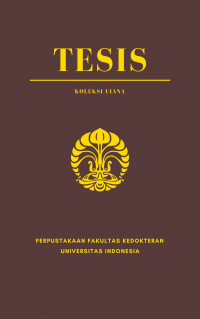Tesis
Uji Toksisitas Komposit Magnesium Karbonat Apatit Dengan Teknik Fabrikasi Sintering Dan Ekstrusi Pada Sel Punca Mesenkimal Sebagai Bahan Dasar Implan Biodegradable Orthopaedi = Toxicity Test of Apatite Carbonate Magnesium Composite With Sintering And Extrusion Fabrication Techniques in Mesenchymal Stem Cells as A Base Material For Orthopedic Biodegradable Implants.
Pendahuluan: Mg (magnesium) yang merupakan salah satu komponen alamiah tubuh mulai banyak diteliti sebagai bahan dasar implan biodegradabel orthopaedi. Salah satu kekurangan Mg adalah tingginya tingkat korosi jika bersentuhan dengan udara. Cara untuk mengurangi tingkat korosi Mg adalah dengan mencampurnya dengan material lain (alloy), melapisi dengan material lain, atau melakukan teknik severe plastic deformity (SPD). Carbonate apatite (CA) dipilih untuk menjadi campuran komposit Mg karena CA merupakan komponen non organik tulang, dan kemampuan osteokonduktivitas nya yang baik. Kendala dari komposit MgCA adalah komposit ini terdegradasi dengan sangat cepat. Penelitian sebelumnya yang dilakukan oleh Rahyussalim dkk terhadap komposit MgCA dengan teknik produksi kompaksi menunjukkan tingkat toksisitas yang tinggi pada sel punca tali pusat manusia. Salah satu penyebab tingginya toksisitas adalah proses korosi. Densifikasi (ekstrusi) merupakan salah satu cara untuk mengurangi proses korosi komposit MgCA. Pada penelitian ini kami membandingkan uji toksisitas pada kelompok komposit MgCA yang difabrikasi dengan menggunakan proses sintering dan ekstrusi. Metode: Komposit MgCA dibuat melalui metode fabrikasi sintering dan ekstrusi (E2010 dan E1210) di Laboratorium Teknik Mesin Fakultas Teknik Universitas Indonesia. Komposisi komposit yang dihasilkan adalah Mg, Mg5CA, Mg10CA dan Mg15CA. Uji toksisitas dilakukan di Laboratorium Stem Cells and Tissue Engineering IMERI, Fakultas Kedokteran Universitas Indonesia. Uji toksisitas dilakukan dengan uji kontak langsung dan uji ekstrak dengan sel punca mesenkimal. Hasil: Implan dengan proses ekstrusi (E2010) memiliki nilai densitas lebih dan kekerasan yang lebih tinggi, laju korosi lebih rendah jika dibandingkan dengan implan dengan proses sintering. Uji ekstrak (MTT) implan yang diproduksi dengan ekstrusi (E2010) menunjukkan hasil non toksik (viabilitas sel > 75%), sedangkan implan dengan teknik produksi sintering dan kompaksi menunjukkan hasil toksik (viabilitas < 75%). Mg15CA ekstrusi (E2010) menunjukkan viabilitas sel terbanyak. Uji kontak langsung menunjukkan toksisitas pada semua jenis implan (viabilitas sel < 70% dibanding kontrol). Kesimpulan: Implan ekstrusi (E2010) memiliki nilai viabilitas sel paling tinggi jika dibandingkan dengan sintering pada uji ekstrak. Semua implan tergolong toksik pada uji kontak langsung.
Kata kunci: Komposit, magnesium, karbonat apatit, ekstrusi, sintering, toksisitas, MTT
Introduction: Mg (magnesium), which is one of the body's natural components, has increasing interests as the basic material for orthopaedic biodegradable implants. One of the disadvantages of Mg is its high corrosion rate when in contact with air. The way to reduce the corrosion rate of Mg is to mix it with other materials (alloys), coat it with other materials, or undergo severe plastic deformity (SPD) technique. Carbonate Apatite (CA) was chosen to be a composite of Mg mixture because CA is an inorganic component of bone, and has good osteoconductivity. The problem with MgCA composite is that they degrade very quickly. Previous research conducted by Rahyussalim et al on MgCA composites with the production technique of compaction showed a high level of toxicity in human umbilical cord stem cells. One of the causes of high toxicity is the corrosion process. Densification (extrusion) is one way to reduce the corrosion process of MgCA composites. In this study, we compared the toxicity test on a group of MgCA composites fabricated using sintering and extrusion processes. Method: The MgCA composites are made through conventional sintering (CS) and extrusion fabrication methods (E2010 and E1210) at the Mechanical Engineering Laboratory, Faculty of Engineering, University of Indonesia. The composition of resulting composite is pure Mg, Mg5CA, Mg10CA and Mg15CA. The toxicity test was carried out at the Stem Cells and Tissue Engineering (SCTE) Laboratory of IMERI, Faculty of Medicine, University of Indonesia. Toxicity test was done by direct contact test and extraction test to the mesenchymal stem cells (MSC). Results: Implants with extrusion process (E2010) have more density and rigidity, lower corrosion rate when compared to other implants that underwent sintering process. Extract test (MTT) of implants produced by extrusion (E2010) showed non-toxic results (cell viability > 75%), while implants with sintering and compaction production techniques showed toxic results (viability < 75%). Mg15CA (E2010) extrusion showed the highest cell viability. Direct contact test showed toxicity to all types of implants (cell viability < 70% compared to control). Conclusion: The extrusion implant (E2010) had the highest cell viability value when compared to sintering in the extracted test. All implants were categorized as toxic in the direct contact test.
Keywords: Composite, magnesium, carbonate apatite, extrusion, sintering, toxicity, MTT
- Judul Seri
-
-
- Tahun Terbit
-
2021
- Pengarang
-
Prima Rizky Oktari - Nama Orang
Sugeng Supriyadi - Nama Orang
RAHYUSSALIM - Nama Orang
Achmad Fauzi Kamal - Nama Orang - No. Panggil
-
T21399fk
- Penerbit
- Jakarta : Program Studi Ilmu Bedah Orthopaedi dan Traumatologi., 2021
- Deskripsi Fisik
-
xv, 66 hal; ill; 21 x 30 cm
- Bahasa
-
Indonesia
- ISBN/ISSN
-
-
- Klasifikasi
-
NONE
- Edisi
-
-
- Subjek
- Info Detail Spesifik
-
Tanpa Hardcopy
| T21399fk | T21399fk | Perpustakaan FKUI | Tersedia |


Masuk ke area anggota untuk memberikan review tentang koleksi